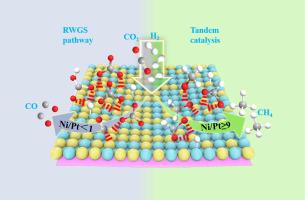Chemical Engineering Science ( IF 4.1 ) Pub Date : 2021-09-08 , DOI: 10.1016/j.ces.2021.117106 Zhongliang Huang 1 , Yujia Yuan 1 , Miaomiao Song 1 , Zhimian Hao 2 , Jingran Xiao 1 , Dongren Cai 1 , Abdul-Rauf Ibrahim 3 , Guowu Zhan 1

|
Herein, we fabricated a series of bimetallic Pt-Ni catalysts supported on mesoporous silica nanorods (mSNR, specific BET surface area of 1802 m2 g−1) to study the effect of Ni/Pt ratio on the product selectivity in CO2 hydrogenation. Both monometallic Pt/mSNR and Ni50Pt50/mSNR catalysts revealed negligible methane selectivity. However, methane became the major product only when increasing the Ni/Pt ratio up to 9. X-ray photoelectron spectroscopy (XPS) and inductively coupled plasma (ICP) characterizations showed that the Pt/Ni ratio on the catalyst surface was appreciably higher than the bulk composition, suggesting the enrichment of Pt on the surface (e.g., Pt/Ni of 61/39 for Ni50Pt50/mSNR catalyst). The Pt/Ni ratio was crucial in determining the CH4/CO selectivity, and the addition of a tiny amount of Pt could improve the catalytic performance and stability of Ni/mSNR. Among the different catalysts, Ni98Pt2/mSNR showed the best CO2 conversion (59%) and CH4 selectivity (96%) at 400 °C, 0.1 MPa, 9600 mL h−1gcat−1, and H2/CO2 of 3. In-situ DRIFTS and temperature-programmed surface experiments suggested that the dissociated adsorption of CO2 on the Pt site led to CO*, but the strongly adsorbed CO* cannot be further hydrogenated to CH4 over the Pt site. In contrast, CO* could be further hydrogenated into CH4 via CHxO* intermediates on adjacent Ni sites.
中文翻译:

介孔 Ni-Pt/SiO2 纳米棒催化剂上的 CO2 加氢:通过 Ni/Pt 的表面比确定 CH4/CO 选择性
在此,我们制备了一系列负载在介孔二氧化硅纳米棒上的双金属 Pt-Ni 催化剂(m SNR,BET 比表面积为 1802 m 2 g -1),以研究 Ni/Pt 比对 CO 2加氢产物选择性的影响. 单金属 Pt/ m SNR 和 Ni 50 Pt 50 / mSNR 催化剂显示出可忽略的甲烷选择性。然而,只有当 Ni/Pt 比率增加到 9 时,甲烷才成为主要产物。 X 射线光电子能谱 (XPS) 和电感耦合等离子体 (ICP) 表征表明,催化剂表面的 Pt/Ni 比率明显高于整体组成,表明 Pt 在表面富集(例如,对于 Ni 50 Pt 50 / m SNR 催化剂,Pt/Ni 为 61/39 )。Pt/Ni比是决定CH 4 /CO选择性的关键,加入微量Pt可以提高Ni/ m SNR的催化性能和稳定性。在不同的催化剂中,Ni 98 Pt 2/ m SNR在 400 °C、0.1 MPa、9600 mL h -1 g cat -1和 H 2 /CO 2为 3 时显示出最佳的 CO 2转化率(59%)和 CH 4选择性(96%)。原位漂移和程序升温表面实验表明,CO 2在 Pt 位点上的解离吸附导致 CO*,但强烈吸附的 CO* 不能在 Pt 位点上进一步氢化为 CH 4。相比之下,CO* 可以通过相邻 Ni 位点上的CH x O* 中间体进一步氢化成 CH 4。











































 京公网安备 11010802027423号
京公网安备 11010802027423号